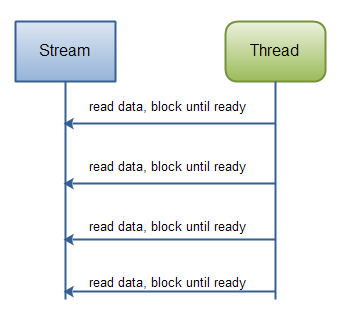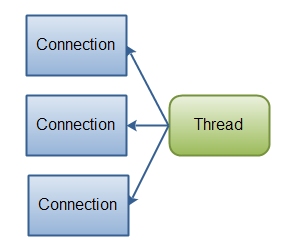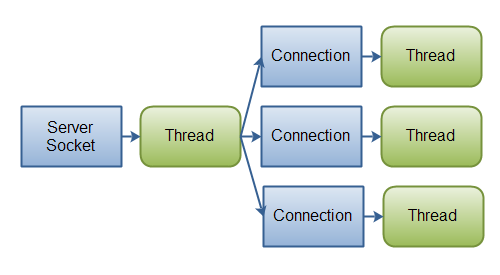When studying both the Java NIO and IO API's, a question quickly pops into mind:
When should I use IO and when should I use NIO?
In this text I will try to shed some light on the differences between Java NIO and IO, their use cases, and how they affect the design of your code.
Main Differences of Java NIO and IO
The table below summarizes the main differences between Java NIO and IO. I will get into more detail about each difference in the sections following the table.
| IO | NIO |
| Stream oriented | Buffer oriented |
| Blocking IO | Non blocking IO |
| Selectors |
Stream Oriented vs. Buffer Oriented
The first big difference between Java NIO and IO is that IO is stream oriented, where NIO is buffer oriented. So, what does that mean?
Java IO being stream oriented means that you read one or more bytes at a time, from a stream. What you do with the read bytes is up to you. They are not cached anywhere. Furthermore, you cannot move forth and back in the data in a stream. If you need to move forth and back in the data read from a stream, you will need to cache it in a buffer first.
Java NIO's buffer oriented approach is slightly different. Data is read into a buffer from which it is later processed. You can move forth and back in the buffer as you need to. This gives you a bit more flexibility during processing. However, you also need to check if the buffer contains all the data you need in order to fully process it. And, you need to make sure that when reading more data into the buffer, you do not overwrite data in the buffer you have not yet processed.
Blocking vs. Non-blocking IO
Java IO's various streams are blocking. That means, that when a
thread invokes a read()
or write()
, that thread is blocked until there is some
data to read, or the data is fully written.
The thread can do nothing else in the meantime.
Java NIO's non-blocking mode enables a thread to request reading data from a channel, and only get what is currently available, or nothing at all, if no data is currently available. Rather than remain blocked until data becomes available for reading, the thread can go on with something else.
The same is true for non-blocking writing. A thread can request that some data be written to a channel, but not wait for it to be fully written. The thread can then go on and do something else in the mean time.
What threads spend their idle time on when not blocked in IO calls, is usually performing IO on other channels in the meantime. That is, a single thread can now manage multiple channels of input and output.
Selectors
Java NIO's selectors allow a single thread to monitor multiple channels of input. You can register multiple channels with a selector, then use a single thread to "select" the channels that have input available for processing, or select the channels that are ready for writing. This selector mechanism makes it easy for a single thread to manage multiple channels.
How NIO and IO Influences Application Design
Whether you choose NIO or IO as your IO toolkit may impact the following aspects of your application design:
- The API calls to the NIO or IO classes.
- The processing of data.
- The number of thread used to process the data.
The API Calls
Of course the API calls when using NIO look different than when
using IO. This is no surprise.
Rather than just read the data byte for byte from e.g. an InputStream
,
the data
must first be read into a buffer, and then be processed from there.
The Processing of Data
The processing of the data is also affected when using a pure NIO design, vs. an IO design.
In an IO design you read the data byte for byte from an InputStream
or
a Reader
. Imagine you were processing a stream of line
based textual data.
For instance:
Name: Anna Age: 25 Email: anna@mailserver.com Phone: 1234567890
This stream of text lines could be processed like this:
InputStream input = ... ; // get the InputStream from the client socket BufferedReader reader = new BufferedReader(new InputStreamReader(input)); String nameLine = reader.readLine(); String ageLine = reader.readLine(); String emailLine = reader.readLine(); String phoneLine = reader.readLine();
Notice how the processing state is determined by how far the program
has executed. In other words,
once the first reader.readLine()
method returns, you
know for sure that a full line
of text has been read. The readLine()
blocks until a
full line is read, that's why.
You also know that this line contains the name. Similarly, when the
second readLine()
call returns, you know that this line contains the age etc.
As you can see, the program progresses only when there is new data to read, and for each step you know what that data is. Once the executing thread have progressed past reading a certain piece of data in the code, the thread is not going backwards in the data (mostly not). This principle is also illustrated in this diagram:
 |
| Java IO: Reading data from a blocking stream. |
A NIO implementation would look different. Here is a simplified example:
ByteBuffer buffer = ByteBuffer.allocate(48); int bytesRead = inChannel.read(buffer);
Notice the second line which reads bytes from the channel into the ByteBuffer
.
When that method call returns you don't know if all the data you
need is inside the buffer.
All you know is that the buffer contains some bytes. This makes
processing somewhat harder.
Imagine if, after the first read(buffer)
call, that all
what was read into the
buffer was half a line. For instance, "Name: An". Can you process
that data? Not really.
You need to wait until at leas a full line of data has been into the
buffer, before it
makes sense to process any of the data at all.
So how do you know if the buffer contains enough data for it to make sense to be processed? Well, you don't. The only way to find out, is to look at the data in the buffer. The result is, that you may have to inspect the data in the buffer several times before you know if all the data is inthere. This is both inefficient, and can become messy in terms of program design. For instance:
ByteBuffer buffer = ByteBuffer.allocate(48);
int bytesRead = inChannel.read(buffer);
while(! bufferFull(bytesRead) ) {
bytesRead = inChannel.read(buffer);
}
The bufferFull()
method has to keep track of how much
data is read into the buffer,
and return either true
or false
, depending
on whether the buffer is
full. In other words, if the buffer is ready for processing, it is
considered full.
The bufferFull()
method scans through the buffer, but
must leave the buffer in
the same state as before the bufferFull()
method was
called. If not, the next
data read into the buffer might not be read in at the correct
location. This is not impossible,
but it is yet another issue to watch out for.
If the buffer is full, it can be processed. If it is not full, you might be able to partially process whatever data is there, if that makes sense in your particular case. In many cases it doesn't.
The is-data-in-buffer-ready loop is illustrated in this diagram:
 |
| Java NIO: Reading data from a channel until all needed data is in buffer. |
Summary
NIO allows you to manage multiple channels (network connections or files) using only a single (or few) threads, but the cost is that parsing the data might be somewhat more complicated than when reading data from a blocking stream.
If you need to manage thousands of open connections simultanously, which each only send a little data, for instance a chat server, implementing the server in NIO is probably an advantage. Similarly, if you need to keep a lot of open connections to other computers, e.g. in a P2P network, using a single thread to manage all of your outbound connections might be an advantage. This one thread, multiple connections design is illustrated in this diagram:
 |
| Java NIO: A single thread managing multiple connections. |
If you have fewer connections with very high bandwidth, sending a lot of data at a time, perhaps a classic IO server implementation might be the best fit. This diagram illustrates a classic IO server design:
 |
| Java IO: A classic IO server design - one connection handled by one thread. |





相关推荐
Peakdet 是一个 NodeJS 库,用于检测数据中的峰谷。 Peakdet 采用的来检测峰值并将其打包为库并添加测试。...// Call the peakdet function, the second argument is the minimum differece // between the
To discover the spectra of them present obvious difference and the spectra for the blood of the different kind of the patient also present obvious differece, but the spectra of the specifieness ...
#CodeQuiz CodeQuiz 是一款使用 Kivy 框架制作的游戏。 他是一个测验由四个选项组成,Ruby、Python、Javascript 和 C#。... 提交它git commit -m 'the differece' 推送它git push origin name-your-feature 创建
标题中的“慧荣2258xt开卡工具”指的是基于慧荣科技(Silicon Motion)SM2258XT主控芯片的闪存设备管理软件。这种工具主要用于对使用该主控芯片的USB闪存盘进行初始化、修复、格式化等操作,被称为“开卡”或“量产...
14个不同版本量产工具合集打包,后缀颗粒支持为主要支持或者支持量比较大的颗粒品牌,其中包含一个支持Intel三贴颗粒的版本,也有一个东芝专版,基本所有没问题的固件跟特殊版固件都有包含在内,未特殊标注的,设置...
3. **SMART监控**:通过SMART(Self-Monitoring, Analysis, and Reporting Technology)技术,软件可以实时监测硬盘的健康状态,预测潜在的硬件故障。 4. **数据恢复**:在数据丢失的情况下,部分高级的修复软件能...